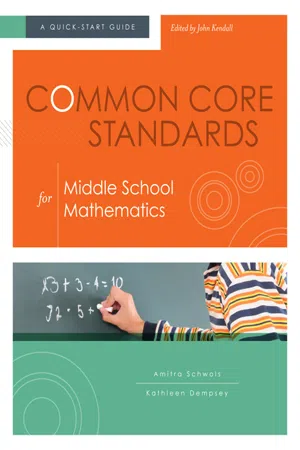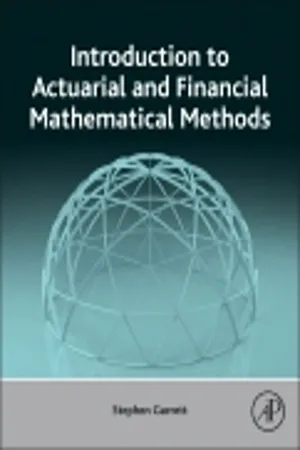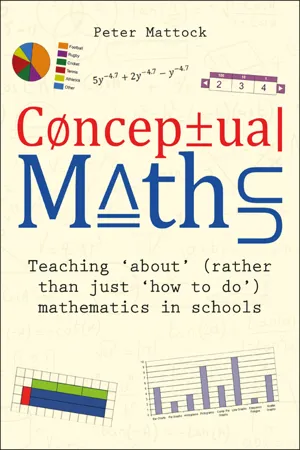Mathematics
Equations and Identities
Equations and identities are fundamental concepts in mathematics. Equations are statements that assert the equality of two expressions, while identities are equations that are true for all values of the variables. These concepts are used extensively in algebra and calculus.
Written by Perlego with AI-assistance
Related key terms
Related key terms
1 of 4
Related key terms
1 of 3
5 Key excerpts on "Equations and Identities"
- eBook - ePub
- Toby Wagner(Author)
- 2021(Publication Date)
- Chemeketa Press(Publisher)
At the end of this section, we will write and solve an equation to find the width of the rectangle in the problem above. In the meantime, let’s learn more about equations.A. Types of Equations
Anequationis a mathematical sentence that asserts that two things are the same or equal. An equals sign (=) means “is the same as.” It’s important, though, to understand that an equation only asserts that two things are the same. As you’ll soon see, this doesn’t guarantee that the statement is actually true.Some equations are always true. These equations are calledidentities. Identities are equations that are true for all acceptable values of the variable. Here are some examples of identities:
About Acceptable Values5x = 5xis true for all acceptable values of x because 5 times any number is always the same as 5 times that same number.y + 1 = y + 1is true for all acceptable values of y because any number plus 1 is always the same as that same number plus 1.2 + 5 = 7 is true, and no substitutions are necessary because this equation doesn’t use any variables. For the equations in the first few chapters of this book, the variables can be replaced with any real number. All real numbers are therefore acceptable values of the variable. Later, you will see equations with more complicated expressions in which some numbers will not be used to replace the variable.Some equations are never true. These equations are called contradictions. Contradictions are equations in which the expression on the left side and the expression on the right side are never equal, no matter what value is substituted for the variable.x = x + 1is never true for any acceptable value of x because no real number is equal to itself plus 1.0 · k = 14is never true for any acceptable value of k because the product of 0 and any real number is always 0. It can never be 14.2 = 1 is never true because 2 can never equal 1. The truth of some equations depends upon the number value chosen for the variable. These equations are calledconditional equations - eBook - ePub
Common Core Standards for Middle School Mathematics
A Quick-Start Guide
- Amitra Schwols, Kathleen Dempsey, John Kendall, John Kendall(Authors)
- 2013(Publication Date)
- ASCD(Publisher)
Chapter 4Expressions and Equations
. . . . . . . . . . . . . . . . . . . .The introduction to the Common Core standards' high school Algebra domain provides some useful definitions to help differentiate the two mathematical terms expression and equation:An expression is a record of a computation with numbers, symbols that represent numbers, arithmetic operations, exponentiation, and, at more advanced levels, the operation of evaluating a function…. An equation is a statement of equality between two expressions, often viewed as a question asking for which values of the variables the expressions on either side are in fact equal. These values are the solutions to the equation. (CCSSI, 2010c, p. 62)The middle school Expressions and Equations (EE) domain provides a critical bridge between content in the Operations and Algebraic Thinking domain in earlier grades and algebraic content students will encounter in high school. Figure 4.1 shows an overview of the Expressions and Equations domain's clusters and standards by grade level. - Stephen Garrett(Author)
- 2015(Publication Date)
- Academic Press(Publisher)
.b.For all p and q in the set of negative real numbers, the product of p and q is in the set of positive real numbers. For example,− 10.6 , − 5.3 ∈, andR −56.18 ∈.R +c.There exists z in the set of integers such that z is less then 7 and is odd. For example, z = 5.d.For all p in the set of rational numbers, there exists q in the set of rational numbers such that 3p = q . For example, p = 4/3 and q = 4.1.3 Algebraic expressions
As we shall see throughout this book, mathematical methods require the manipulation of mathematical expressions. At this stage, it is important to define what we mean by the distinct types of mathematical expressions: equations , identities , inequalities , and functions . The distinction between these terms is the topic of this section, and functions will be considered in detail in Chapter 2 .1.3.1 Equations and Identities
The key distinction between an equation and an identity is the number of values of the independent variable (x in Eqs. 1.2 and 1.3 ) for which the expression is true. An identity is true for all values of the independent variable, but this is not true of an equation.Put another way, for an identity, it is possible to show that the expression on the left-hand side (LHS) of the equal sign is algebraically equal to that on the right-hand side (RHS). This is not true of an equation and one might be required to find the particular values of the independent variable for which the equality between the LHS and RHS holds. In general, an equation could have a finite or infinite number of values of the independent variable for which the equality holds; typically we might refer to these values of the independent variable as the solutions of the equation.Consider the following expression:= x + 10( x + 4 )2(1.2)It should be immediately clear that Eq. (1.2 ) is not an identity. In particular, we might note that the LHS is a quadratic expression, that is the highest power of x is 2, and the RHS is linear, that is the highest power of x is 1. For this reason the behavior of the LHS and the RHS will be very different as x takes different values. We return to a discussion of polynomials in Chapter 2- eBook - ePub
Well Played, Grades 6-8
Building Mathematical Thinking Through Number and Algebraic Games and Puzzles
- Linda Dacey, Karen Gartland, Jayne Bamford Lynch(Authors)
- 2023(Publication Date)
- Routledge(Publisher)
Chapter 5 Expressions and EquationsDOI: 10.4324/9781032683027-5What's the Math?
The study of expressions and equations helps students to transition from their work with number and operations in elementary school to the level of conceptual understanding needed for algebra. Previously, students have applied the properties of operations to rational numbers; now, they apply these ideas to variables. Success in this area is essential for later achievement in high school mathematics and in solving real-world problems. The National Research Council defines two key features of algebra as “(a) a systematic way of expressing generality and abstraction including algebra as generalized arithmetic and (b) a guided transformation of symbols such as we do when we solve equations by collecting like terms and using inverse operations” (NRC 2001 , 256).As students work with expressions and equations, there is ample opportunity for them to reason quantitatively and abstractly as well as to construct and understand viable arguments. Attention to justification helps students to connect prior knowledge about numbers to that of variables. According to Michael Cioe and his coauthors (2015), justification goes well beyond students showing their work, as it involves why, not just how. Playing and solving these puzzles and games in teams requires students to justify their thinking and to analyze the thinking of others.In sixth grade, students read, write, and evaluate expressions, and translate an expression such as 6 less than x to x – 6. Students use the properties of operations to recognize and generate equivalent expressions and to solve one-step equations and inequalities. They apply these ideas to the solution of real-world problems. In seventh grade, students extend these concepts and skills to the inclusion of rational numbers and the solution of multistep, real-world problems with positive and negative rational numbers. Students at this grade level also use mental computation and estimation strategies to assess the reasonableness of answers. In eighth grade, students solve linear equations efficiently and solve systems of linear equations with two variables. Students also make connections with other units of study as they use equations to express proportional relationships and apply their knowledge of functions in the interpretation of linear relationships (Gartland 2014 - eBook - ePub
Conceptual Maths
Teaching 'about' (rather than just 'how to do') mathematics in schools
- Peter Mattock(Author)
- 2023(Publication Date)
- Crown House Publishing(Publisher)
– where necessary, using the tiles should illustrate the mistake sufficiently.Where we tend to see the ≡ symbol more is when we are talking about equivalent algebraic expressions. Again, this is a situation where, for me, the choice of using the equal sign or the equivalent sign should highlight whether we are drawing attention to equal value or to equivalent properties. For example, we have previously written that (x + 2)(x + 3) = x2 + 5x + 6, but we could equally write (x + 2)(x + 3) ≡ x2 + 5x + 6. It would seem to make sense that in the first case, we are drawing attention to the fact that the values obtained from each expression are equal. In the second case, it is more about seeing the two as equivalent expressions with the same properties, i.e. the same graphical properties, the same order, etc. Of course, we do therefore need to be clear with pupils the difference between writing (x + 2)(x + 3) = x2 + 5x + 6, and (x + 2)(x + 3) = 0 (and I know some people that advocate for only ever writing (x + 2)(x + 3) ≡x2 + 5x + 6).When we do write things like (x + 2)(x + 3) ≡ x2 + 5x + 6, we usually refer to the relationship as an identity. Taken together, this means an identity is an equivalence between two expressions. It is definitely a good idea for pupils to work on determining between solvable equations, identities, formulae, functions, etc. There is a nice activity on TES that provides different types of expressions, equations, etc. and prompts pupils to sort them under the correct heading.10Pupils can be offered the opportunity to prove different identities such as that as well as to solve equations created using identities, such as the example below:The symbol ≡ is also used in geometry to denote congruence. It is with an examination of this concept that we will complete this chapter.If ax(x + b) + c ≡ 3x2 + 15x − 11, then work out the values of a, b and c.
Index pages curate the most relevant extracts from our library of academic textbooks. They’ve been created using an in-house natural language model (NLM), each adding context and meaning to key research topics.
Explore more topic indexes
Explore more topic indexes
1 of 6
Explore more topic indexes
1 of 4




